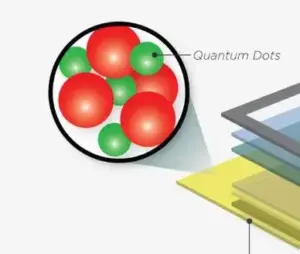The nation of South Korea has taken the threat to its OLED dominance to heart or, at least, that’s what it seems like after news of China’s growing market share in smartphone OLEDs. The Ministry of Trade, Industry and Energy has announced that the government is investing 1 trillion won ($750 billion) in inorganic light emitting diode development to ensure Korea’s display industry stays ahead of the rest of the world on next gen technologies.
At a technology steering committee meeting, a pan-government research and development body the emphasis was on three areas of focus for the display industry: stabilizing the supply chain, moving into a market leading role on inorganic display technologies, and pursuing opportunities in new form factors such as flexible displays. The committee highlighted the importance of localizing materials production and equipment production for the display industry. It also emphasized the importance of sub-5 nanometer display technology for the future of Korea’s market dominance because of the higher resolutions and lower power consumption, but mostly because the Koreans see accelerating the commercialization of these technologies as being a competitive wedge against China’s pursuit of the OLED market. Finally, flexible, stretchable, rollable, and foldable displays were seen as requiring a retooling of the industry, and investment by Korean companies was essential to create market momentum for the country’s manufacturers.
Asan City Shortlisted for the Establishment of a State-of-the-Art Display Technology Center
Asan City in South Chungcheong Province has been chosen as a candidate location for the establishment of the “Inorganic Luminescent Display Technology Development and Ecosystem Construction Smart Modular Center” by the government. Something may have gotten lost in the translation of the name but inorganic luminescent displays refers to things like MicroLED, NanoLED, and quantum dots (QD), the next generation beyond OLED, according to government messsaging.
According to reports in the Korean press, following its designation as a national strategic industry special zone for display technology last July, the city, in collaboration with South Chungcheong Province, is gearing up to submit preliminary feasibility planning reports and further evaluations.
The project, slated to run from 2025 to 2032, will involve an investment of 950 billion won ($717 million) of which the Korean government is coughing up about $561 million. The total investment includes 790.5 billion ($596 million) for panel production, as well as product innovation R&D for inorganic displays, and 159.5 billion ($120 million) for the construction of the Smart Modular Center. The Smart Modular Center is planned to be built on a 4,000 square meters (roughly 43,000 square feet) site in Asan City. It will be equipped with testing and evaluation facilities and clean rooms.
By winning this bid and initiating the project, Asan City anticipates multiple benefits, including securing core technologies for inorganic displays, enhancing price competitiveness and market dominance for local industry, increasing the domestic production of key components, and fostering innovative startups and businesses in this field.

